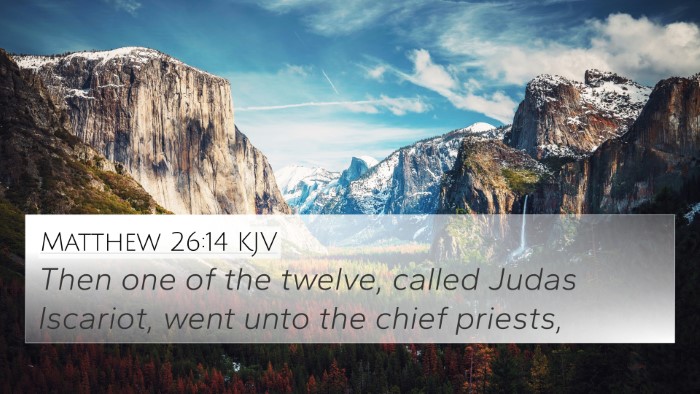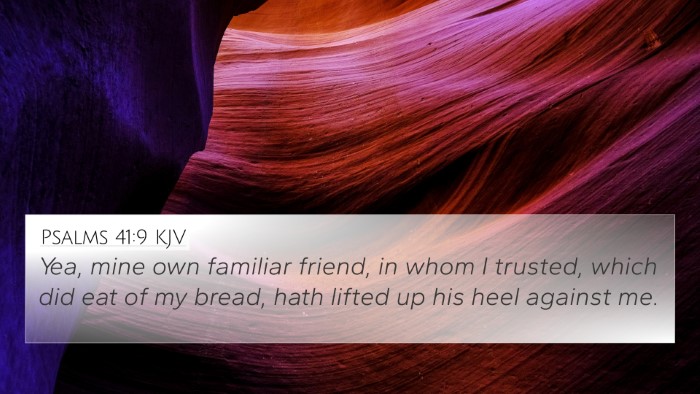Understanding Mark 14:10
Mark 14:10 states, "And Judas Iscariot, one of the twelve, went unto the chief priests to betray him." This pivotal verse marks the beginning of the most significant events leading to the crucifixion of Jesus. Here, we explore its meaning through the insights of public domain commentaries, including Matthew Henry, Albert Barnes, and Adam Clarke, along with cross-references illuminating its significance.
Context of the Verse
In the Gospel of Mark, the narrative is moving toward the climax of Jesus' ministry and the events leading to his death. This verse reveals Judas's intentions, foreshadowing the betrayal that will have lasting implications on the Christian faith.
Commentary Insights
Matthew Henry's Commentary
Matthew Henry highlights the treachery of Judas, noting that he was one of the twelve disciples chosen to follow Jesus. His betrayal emphasizes the depth of human sinfulness and the stark contrast between the loyalty expected from a disciple and Judas's actions. Henry suggests that Judas's actions were motivated by greed, as seen in other Gospel accounts. This act of betrayal acts as a catalyst for the fulfillment of the prophecies surrounding the Messiah.
Albert Barnes' Commentary
Albert Barnes sheds light on Judas's motivations, indicating that his decision to betray Jesus was premeditated and calculated. Barnes suggests that this betrayal was not merely for monetary gain but also arises from a deeper conflict within Judas, reflecting on how he had become disillusioned with Jesus' ministry. Barnes also outlines the gravity of Judas's choice and its implications, setting up the necessity of Jesus's sacrificial atonement.
Adam Clarke's Commentary
Adam Clarke provides a critical analysis of the socio-political context of the time, explaining that the chief priests viewed Jesus as a threat to their authority. Clarke notes that Judas went to the chief priests, indicating a betrayal not only of Jesus but also of the covenant community that he was once a part of. His act of betrayal serves as a demonstration of the influence of earthly powers over the spiritual realm, illustrating conflicts that still resonate within Christian teachings today.
Bible Verse Cross-References
Mark 14:10 can be connected with several other Bible verses that deepen its understanding:
- Matthew 26:14-16 - Provides a parallel account of Judas’s agreement to betray Jesus for thirty pieces of silver.
- Luke 22:3-6 - Discusses how Satan entered Judas, emphasizing the spiritual dimension of betrayal.
- John 13:2 - Indicates that the devil put it into the heart of Judas to betray Jesus, connecting spiritual influence with human decisions.
- Zachariah 11:12-13 - A prophetic reference regarding the price of betrayal, foreshadowing Judas's actions.
- Matthew 27:3-5 - Relates Judas's remorse and ultimate fate after the betrayal, providing insight into the consequences of his actions.
- Psalm 41:9 - Speaks of the betrayal of a close friend, resonating with the themes of betrayal and fulfillment of scripture.
- Acts 1:16-20 - Discusses the fulfillment of prophecy concerning Judas's betrayal and subsequent demise.
Thematic Connections
This verse is rich with themes that recur throughout Scripture:
- Betrayal: The story of Judas is deeply intertwined with the theme of betrayal, influencing how other figures in the Bible demonstrate loyalty or disloyalty.
- Greed and Materialism: Judas's decision to betray Jesus for financial gain speaks to broader themes in the Bible about the dangers of loving money over God.
- Prophecy and Fulfillment: Judas's actions were foretold in Scripture, linking the Old Testament with the New Testament in a continuous narrative of God's plan.
Understanding Through Cross-Referencing
Engaging in cross-referencing Biblical texts allows readers to see connections clearly. Tools for Bible cross-referencing can provide insights into how verses interact with each other, enhancing the understanding of themes, characters, and prophecies. How to use Bible cross-references effectively can illuminate one’s study and discussion group findings, making revelations clearer.
Conclusion
Mark 14:10 serves as a crucial verse within the context of Jesus's passion narrative. Through comparative Bible verse analysis, one can see the profound implications of betrayal, the intersection of divine prophecy and human choice, and the enduring relevance of these themes. As believers study this verse and its connections, they find deeper understanding and reflections on their spiritual journeys.
In summary, engaging with this verse—along with its allegorical cross-references and thematic discussions—deepens one’s understanding of the relational dynamics within the scripture, guiding them in personal reflection and corporate worship.











